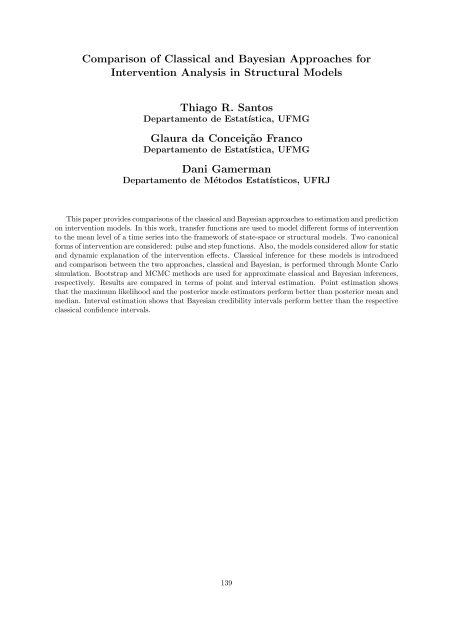Untitled - UFRJ
Untitled - UFRJ Untitled - UFRJ
Comparison of Classical and Bayesian Approaches forIntervention Analysis in Structural ModelsThiago R. SantosDepartamento de Estatística, UFMGGlaura da Conceição FrancoDepartamento de Estatística, UFMGDani GamermanDepartamento de Métodos Estatísticos, UFRJThis paper provides comparisons of the classical and Bayesian approaches to estimation and predictionon intervention models. In this work, transfer functions are used to model different forms of interventionto the mean level of a time series into the framework of state-space or structural models. Two canonicalforms of intervention are considered: pulse and step functions. Also, the models considered allow for staticand dynamic explanation of the intervention effects. Classical inference for these models is introducedand comparison between the two approaches, classical and Bayesian, is performed through Monte Carlosimulation. Bootstrap and MCMC methods are used for approximate classical and Bayesian inferences,respectively. Results are compared in terms of point and interval estimation. Point estimation showsthat the maximum likelihood and the posterior mode estimators perform better than posterior mean andmedian. Interval estimation shows that Bayesian credibility intervals perform better than the respectiveclassical confidence intervals.139
Metodologia Bayesiana para Detecção de Itens Assimétricos emModelos da Teoria de Resposta do ItemVera Lúcia Filgueira dos SantosUFRJDani GamermanUFRJTufi Machado SoaresUFJFA Teoria de Resposta ao Item (TRI) para respostas dicotômicas considera, em geral, um conjunto deJ itens aplicados a I indivíduos. Os modelos simétricos mais utilizados para descrever a probabilidadede resposta correta a tais itens, também conhecidos como Curvas Características dos Itens (CCI), são asdistribuições Normal e Logística. Esses modelos levam em conta os parâmetros dos itens (a discriminação,a dificuldade e a probabilidade de acerto ao acaso) e a habilidade ou traço latente dos indivíduos paracaracterizar tais probabilidades. Entretanto, à medida que o uso da TRI cresce, surgem algumas questões,como por exemplo, se as CCI’s simétricas comumente utilizadas são adequadas.O principal objetivo deste trabalho é propor generalizações do modelo simétrico de três parâmetros,onde um parâmetro de assimetria é incorporado com o intuito de permitir formas mais geraispara as CCI’s. Tais generalizações diferem entre si na modelagem deste parâmetro: em uma delas,um mecanismo para detecção de itens assimétricos será considerado. Estudos simulados serão feitosutilizando metodologia Bayesiana e implementando via métodos MCMC. Posteriormente, um conjuntode dados reais será analisado.140
- Page 89 and 90: Modelos de Volatilidade Estocástic
- Page 91 and 92: Processo de Difusão Multivariado c
- Page 93 and 94: Generalized Latent Factor Models fo
- Page 95 and 96: Measuring Vulnerability via Spatial
- Page 97 and 98: Medidas do Valor Preditivo de um Mo
- Page 99 and 100: Aproximações Analíticas para Pos
- Page 101 and 102: Modelo de Risco Logístico Dependen
- Page 103 and 104: A Practical Approach to Elicit Mult
- Page 105 and 106: Modelos Dinâmicos para Deformaçã
- Page 107 and 108: A Semiparametric Bayesian Approach
- Page 109 and 110: Modelo Weibull Modificado de Longa
- Page 111 and 112: Abordagem Bayesiana para Modelos GA
- Page 113 and 114: Modelo Bayesiano Geral de Classe La
- Page 115 and 116: Métodos de Estimação em Modelos
- Page 117 and 118: LASSO Bayesiano no Mapeamento de QT
- Page 119 and 120: Estudo das Matrizes de Covariância
- Page 121 and 122: Sensibilidade da Inferência Bayesi
- Page 123 and 124: Análise Bayesiana para o Estudo de
- Page 125 and 126: Uma Abordagem Bayesiana para Modelo
- Page 127 and 128: Construção de Tábuas de Mortalid
- Page 129 and 130: Um Procedimento Bayesiano para a An
- Page 131 and 132: Um Novo Modelo para Dependência Es
- Page 133 and 134: Distribuição Geométrica Exponenc
- Page 135 and 136: Morbidade Pulmonar e Condições Cl
- Page 137 and 138: Standard Setting for a Rasch Poisso
- Page 139: Modelo Logístico Misto com Classes
- Page 143 and 144: Modelos Espaço-Temporais para Dado
- Page 145 and 146: Comparação de Modelos para a Iden
- Page 147 and 148: Modelos Multivariados de Regressão
- Page 149 and 150: Estimação Bayesiana em Modelos de
- Page 151 and 152: Previsão de Resultados de Jogos de
- Page 153 and 154: Uma Abordagem Bayesiana para Modelo
- Page 155 and 156: Análise Bayesiana do Modelo Log-Bi
- Page 157 and 158: Desempate TécnicoFilipe Jaeger Zab
- Page 159 and 160: 10 o Encontro Brasileiro de Estatí
- Page 161 and 162: 10 o Encontro Brasileiro de Estatí
- Page 163: 10 o Encontro Brasileiro de Estatí
Comparison of Classical and Bayesian Approaches forIntervention Analysis in Structural ModelsThiago R. SantosDepartamento de Estatística, UFMGGlaura da Conceição FrancoDepartamento de Estatística, UFMGDani GamermanDepartamento de Métodos Estatísticos, <strong>UFRJ</strong>This paper provides comparisons of the classical and Bayesian approaches to estimation and predictionon intervention models. In this work, transfer functions are used to model different forms of interventionto the mean level of a time series into the framework of state-space or structural models. Two canonicalforms of intervention are considered: pulse and step functions. Also, the models considered allow for staticand dynamic explanation of the intervention effects. Classical inference for these models is introducedand comparison between the two approaches, classical and Bayesian, is performed through Monte Carlosimulation. Bootstrap and MCMC methods are used for approximate classical and Bayesian inferences,respectively. Results are compared in terms of point and interval estimation. Point estimation showsthat the maximum likelihood and the posterior mode estimators perform better than posterior mean andmedian. Interval estimation shows that Bayesian credibility intervals perform better than the respectiveclassical confidence intervals.139



